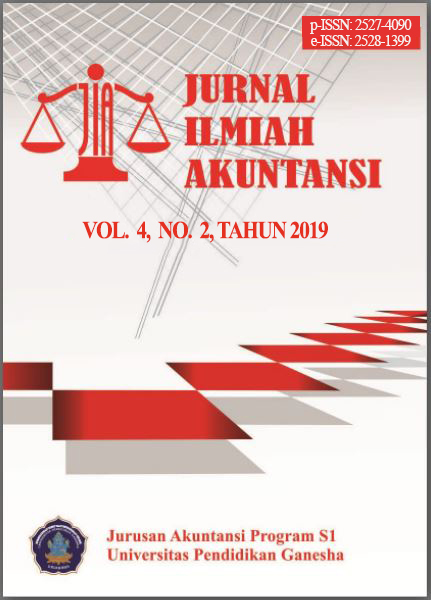Tax Avoidance & Corporate Risk: An Empirical Study in Manufacturing Company
DOI:
https://doi.org/10.23887/jia.v4i2.21886Abstract
The purpose of this research is to test whether a company tax avoidance activity would affect the corporate risk. Tax avoidance measurement is done by applying cash effective tax rate formula, while the volatility rate of stock return formula is used to measure corporate risk. This research also testing the connection between cash effective tax rate and future tax rate volatility. This research shows that tax avoidance activity would impact both corporate risk and future tax rate volatility. Hopefully, the result of this research would help the decision makers such as the company’s managers who plans to do tax avoidance and the investors in making investment.
References
Ayers, B. C., Laplante, S. K., & McGuire, S. T. (2010). Credit ratings and taxes: The effect of book-tax differences on ratings changes. Contemporary Accounting Research. https://doi.org/10.1111/j.1911-3846.2010.01011.x
Balakrishnan, K., Blouin, J. L., & Guay, W. R. (2019). Tax aggressiveness and corporate transparency. Accounting Review. https://doi.org/10.2308/accr-52130
Desai, M. A., & Dharmapala, D. (2006). Corporate tax avoidance and high-powered incentives. Journal of Financial Economics. https://doi.org/10.1016/j.jfineco.2005.02.002
Desai, M. A., & Dharmapala, D. (2009). Corporate tax avoidance and firm value. Review of Economics and Statistics. https://doi.org/10.1162/rest.91.3.537
Dhaliwal, D. S., Lee, H. S. (Grace), Pincus, M., & Steele, L. B. (2017). Taxable income and firm risk. Journal of the American Taxation Association. https://doi.org/10.2308/atax-51610
Dyreng, S. D., Hanlon, M., & Maydew, E. L. (2008). Long-run corporate tax avoidance. Accounting Review. https://doi.org/10.2308/accr.2008.83.1.61
Dyreng, S. D., Hanlon, M., & Maydew, E. L. (2019). When does tax avoidance result in tax uncertainty? Accounting Review. https://doi.org/10.2308/accr-52198
Eisenhardt, K. M. (1989). Agency Theory: An Assessment and Review. The Academy of Management Review. https://doi.org/10.2307/258191
Goh, B. W., Lee, J., Lim, C. Y., & Shevlin, T. (2016). The effect of corporate tax avoidance on the cost of equity. Accounting Review. https://doi.org/10.2308/accr-51432
Guenther, D. A., Matsunaga, S. R., & Williams, B. M. (2017). Is tax avoidance related to firm risk? Accounting Review. https://doi.org/10.2308/accr-51408
Hanlon, M., & Heitzman, S. (2010). A review of tax research. Journal of Accounting and Economics. https://doi.org/10.1016/j.jacceco.2010.09.002
Hanlon, M., & Slemrod, J. (2009). What does tax aggressiveness signal? Evidence from stock price reactions to news about tax shelter involvement. Journal of Public Economics. https://doi.org/10.1016/j.jpubeco.2008.09.004
Jensen, N., & Meckling, W. (1976). Theory of the firm: Managerial behavior, agency costs, and capital structure. Journal of Financial Economics.
Kim, J. B., Li, Y., & Zhang, L. (2011). Corporate tax avoidance and stock price crash risk: Firm-level analysis. Journal of Financial Economics. https://doi.org/10.1016/j.jfineco.2010.07.007
Lev, B., & Nissim, D. (2004). Taxable income, future earnings, and equity values. Accounting Review. https://doi.org/10.2308/accr.2004.79.4.1039
Lim, Y. (2011). Tax avoidance, cost of debt and shareholder activism: Evidence from Korea. Journal of Banking and Finance. https://doi.org/10.1016/j.jbankfin.2010.08.021
Mardiasmo. (2016). Perpajakan Edisi Terbaru 2016. In Penerbit ANDI.
Reily, M. (2017). Menperin: Sumbangan Pajak Industri Manufaktur Tumbuh 16,63%.
Suandy, E. (2011). Perencanaan Pajak. In Perencanaan Pajak (Edisi 5).
Waluyo. (2013). Perpajakan Indonesia (11th ed.). Jakarta: Salemba Empat.
Wiyarti, S. (2015). Pengamat: Pajak di Indonesia Masih Mudah Diakali.



1.png)


